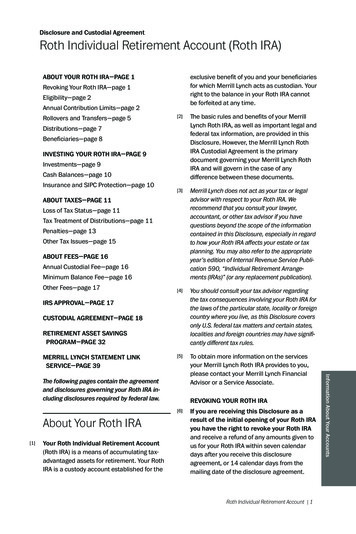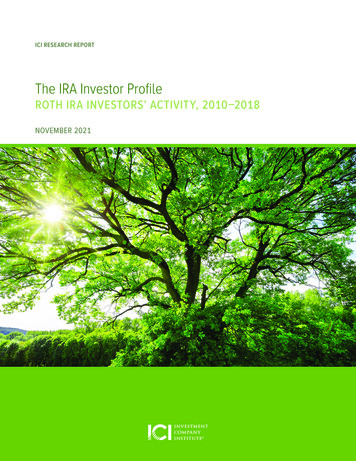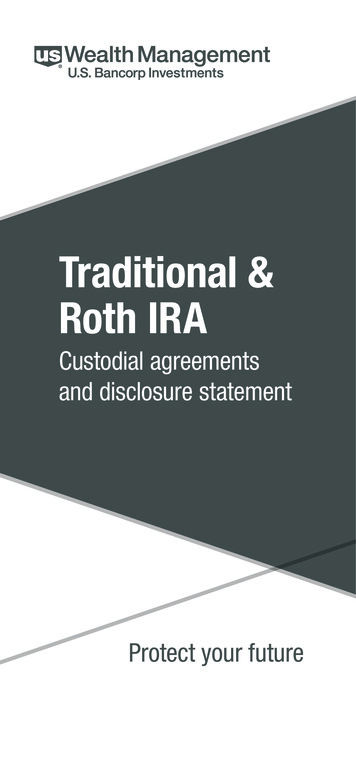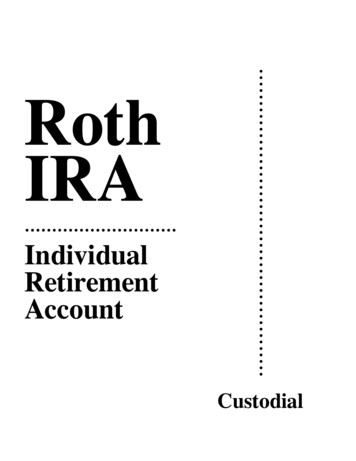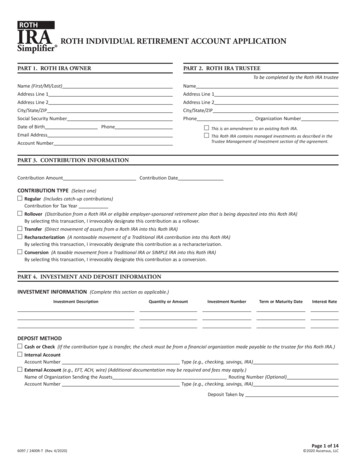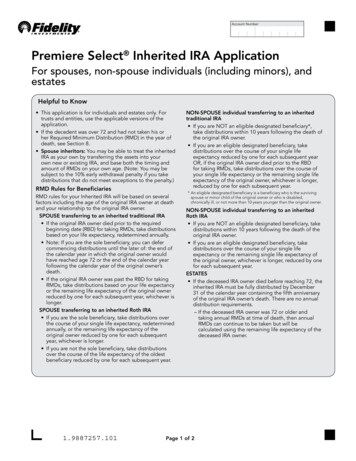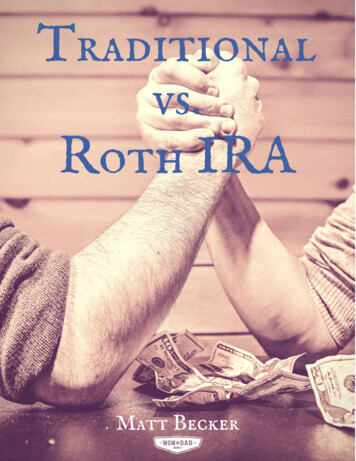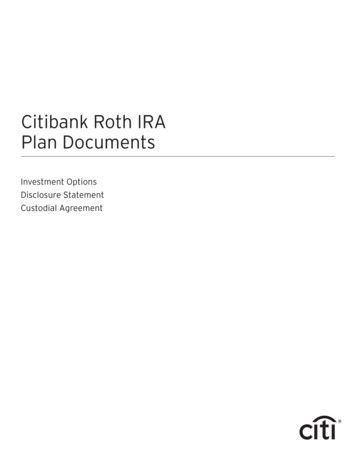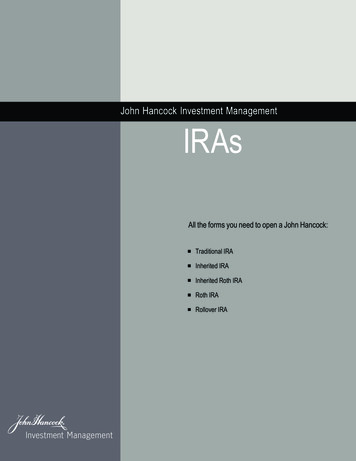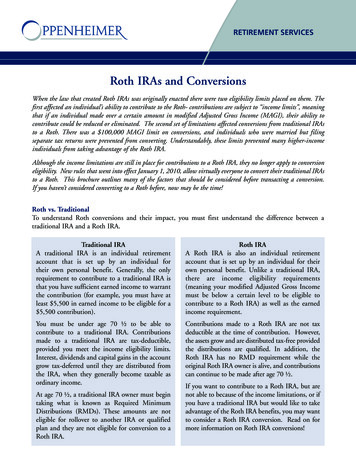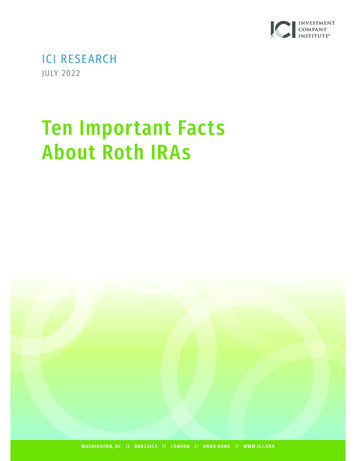
Transcription
ICI RESE ARCHJULY 2022Ten Important FactsAbout Roth IRAsW A S H I N G T O N , D C // B R U S S E L S // L O N D O N // H O N G K O N G // W W W . I C I . O R G
Individual Retirement Accounts (IRAs)Individual retirement accounts (IRAs), created in 1974 by the Employee Retirement IncomeSecurity Act (ERISA), have helped millions of US households save for retirement. Congressoriginally designed traditional IRAs to give individuals not covered by retirement plans atwork a tax-advantaged savings plan, and to play a complementary role to the employersponsored retirement system by preserving rollover assets at job change or retirement.Since then, policymakers have changed rules surrounding IRAs and introduced new typesof IRAs, such as the Roth IRA, which was created by the Taxpayer Relief Act of 1997.The Investment Company Institute (ICI) is the leading association representing regulated investment funds. ICI’smission is to strengthen the foundation of the asset management industry for the ultimate benefit of the longterm individual investor. Its members include mutual funds, exchange-traded funds (ETFs), closed-end funds, andunit investment trusts (UITs) in the United States, and UCITS and similar funds offered to investors in Europe,Asia and other jurisdictions. ICI has offices in Washington, DC, Brussels, London, and Hong Kong and carries outits international work through ICI Global.Suggested citation: Investment Company Institute. 2022. Ten Important Facts About Roth IRAs. Available opyright 2022 by the Investment Company Institute. All rights reserved.
Ten Important Facts About Roth IRAsContents2FACT 1More than one-third of IRA investors have Roth IRAs.4FACT 2One-third of Roth IRA investors are younger than 40.6FACT 3Roth IRAs are most commonly opened with contributions.8FACT 4Roth IRA investors display persistence in their contribution activity.10FACT 5Roth IRA rollover activity is rare.12FACT 6Roth IRAs are held at a variety of financial services firms.14FACT 7Equity holdings figure prominently in Roth IRA investments.16FACT 8Roth IRA–owning households’ retirement planning strategies have many components.18FACT 9Most Roth IRA owners consult a financial professional when creating a retirement strategy.20FACT 10Few Roth IRA investors take withdrawals.
1More than one-thirdof IRA investorshave Roth IRAs.Americans held 13.9 trillion in individual retirement accounts (IRAs)at year-end 2021, with Roth IRAs accounting for 1.3 trillion of thattotal. Forty-five percent of IRA assets, or 6.2 trillion, were investedin mutual funds. The most common type of IRA is the traditionalIRA, which was created by the Employee Retirement IncomeSecurity Act of 1974 (ERISA). The second most common type is theRoth IRA, created by the Taxpayer Relief Act of 1997. Thirty-eightpercent of Roth IRA–owning households in 2021 indicated theirRoth IRA was the first type of IRA they opened. Households ofteninvest in both traditional and Roth IRAs—67 percent of Roth IRA–owning households in 2021 also owned traditional IRAs. Seventyseven percent of IRA investors in 2021 owned traditional IRAs and57 percent owned Roth IRAs. About 18 percent of IRA investors hademployer-sponsored IRAs.2 // Ten Important Facts About Roth IRAs
More Than One-Third of IRA Investors Have Roth IRAsDistribution of IRA investors and assets, percentage of total, year-end 20182018 IRA universe12018 IRA Investor DatabasePercentage of IRA investors27959Traditional35 39Roth5 55 12SEP and SAR-SEPSIMPLEType of IRAPercentage of IRA assets85759Traditional16Roth5 51 4SEP and SAR-SEPSIMPLEType of IRA1In the IRS universe, data are for IRA investors of all ages.2These percentages add to more than 100 percent because investors may own more than one type of IRA.Note: The 2018 IRS universe includes 61.5 million IRA investors with 9,135 billion in assets at year-end2018. The 2018 IRA Investor Database includes 10.7 million IRA investors with 997 billion in assets atyear-end 2018.Sources: The IRA Investor DatabaseTM and Internal Revenue Service Statistics of Income Division; seeFigure A.2 in “The IRA Investor Profile: Roth IRA Investors’ Activity, 2010–2018,” ICI Research Report(November 2021)3
2One-third of RothIRA investors areyounger than 40.IRAs are owned by individuals of all ages, but Roth IRAinvestors tend to be younger than traditional IRA investors.At year-end 2018, 33 percent of Roth IRA investors wereyounger than 40, compared with only 16 percent oftraditional IRA investors. Twenty-six percent of Roth IRAinvestors were 60 or older, compared with 44 percent oftraditional IRA investors. This age pattern reflects thedifferent key role of Roth IRAs, which tend to be openedby contributions, versus traditional IRAs, which tend to beopened with rollovers—an activity that tends to occur laterin one’s career or at retirement.4 // Ten Important Facts About Roth IRAs
One-Third of Roth IRA Investors Are Younger Than 40Percentage of total, year-end 2018Age of IRA investor60 or older40 to 59Younger than 4026444470413933Roth IRAinvestors401716Roth IRAassetsTraditional IRAinvestors273Traditional IRAassetsNote: The sample is 4.1 million Roth IRA investors (aged 18 or older) holding 156.0 billion in Roth IRA assetsat year-end 2018 and 6.3 million traditional IRA investors (aged 18 or older) holding 746.7 billion traditionalIRA assets at year-end 2018.Source: The IRA Investor Database ; see Figure A.3 in “The IRA Investor Profile: Roth IRA Investors’ Activity,2010–2018,” ICI Research Report (November 2021)5
3Roth IRAs are mostcommonly openedwith contributions.Roth IRAs can be opened with contributions (subjectto income limits), conversions (subject to income limitsbefore 2010), or rollovers (allowed directly from non-Rothemployer-sponsored retirement plan accounts since 2008,although subject to income limits before 2010; and alloweddirectly from designated Roth accounts in employersponsored retirement plans since 2006, the first year theywere available). In a typical year, the most common pathto Roth IRA ownership is through contributions. In tax year2018, 76 percent of new Roth IRAs were opened only withcontributions. In contrast, 10 percent were opened only withconversions, and 9 percent were opened only with rollovers.6 // Ten Important Facts About Roth IRAs
Roth IRAs Are Most Commonly Opened with ContributionsPercentage of new Roth IRAs, 201876%Contribution only10%Conversion only9%Rollover only5%Combination of contribution,conversion, and/or rolloverNote: New Roth IRAs are accounts that did not exist in The IRA Investor Database in 2017 and were opened in2018 by one of the paths indicated. The calculation excludes Roth IRAs that changed financial services firms.The sample is 0.2 million new Roth IRA investors aged 18 or older at year-end 2018.Source: The IRA Investor DatabaseTM; see Figure E.2 in “The IRA Investor Profile: Roth IRA Investors’ Activity,2010–2018,” ICI Research Report (November 2021)7
4Roth IRAinvestors displaypersistence intheir contributionactivity.The contribution activity of Roth IRA investors withaccounts at year-end 2017 and year-end 2018 shedslight on the persistence of contributions. In tax year2017, 34 percent of these Roth IRA investors madecontributions to their Roth IRAs, and 40 percent ofthose contributing did so at the limit. In addition,individuals using Roth IRAs as a contributory savingsvehicle tend to contribute from year to year. Forexample, 70 percent of Roth IRA investors contributingat the limit in tax year 2017 contributed at the limit intax year 2018 as well.8 // Ten Important Facts About Roth IRAs
Most Roth IRA Investors at the Limit in Tax Year 2017 Continued toContribute at the Limit in Tax Year 20182017 contribution amountPercentage of Roth IRA investorspresent in both 2017 and 20182018 contribution amountPercentage of Roth IRA investorsby 2017 contribution amount13.6%Contributedat the limit 220.8%Contributed less thanthe limit 265.6%70.110.919.17.0Contributed at the limit 2Contributed less than the limit 2Made no contributionContributed at the limit 275.9Contributed less than the limit 217.1Made no contributionMade no contribution11Among the 65.6 percent of Roth IRA investors who did not contribute in tax year 2017, 2.4 percentcontributed at the limit in tax year 2018 and 2.6 percent contributed less than the limit in tax year 2018.2The contribution limit in tax years 2017 and 2018 was 5,500 for Roth IRA investors younger than 50 and 6,500 for Roth IRA investors aged 50 or older. Income limits may phase these amounts down for sometaxpayers. Investors were considered at the limit if they contributed their full age-allowed amount.Note: The sample is 3.8 million Roth IRA investors aged 19 or older in 2018 with Roth IRA balances in both2017 and 2018.Source: The IRA Investor Database ; see Figure 2.8 in “The IRA Investor Profile: Roth IRA Investors’ Activity,2010–2018,” ICI Research Report (November 2021)9
5Roth IRA rolloveractivity is rare.In contrast to traditional IRAs, which often are opened with rollovers,rollovers into Roth IRAs are relatively rare. Roth IRAs have alwaysbeen permitted to accept rollovers from other Roth IRAs, and since2006 they have been able to accept rollovers directly from designatedRoth accounts in employer-sponsored retirement plans (which couldbe established starting in 2006). Direct rollovers of non-Roth qualifiedretirement plan accumulations into Roth IRAs have been permittedsince 2008. In the database, rollovers between IRAs generally are notreported as rollovers; rather, the database tends to capture rolloversfrom employer-sponsored retirement plans. In any given year, less than3 percent of Roth IRA investors had rollovers into their Roth IRAs. Thislow number could be explained by the fact that rollovers tend not to berepeated from year to year—but even when rollover activity is aggregatedfrom 2007 to 2018, only 7.8 percent of Roth IRA investors at year-end2018 had made rollovers into their Roth IRAs.10 // Ten Important Facts About Roth IRAs
Very Few Roth IRA Investors Have RolloversPercentage of Roth IRA investors aged 18 or older with rollovers1IRS universe 27.8The IRA Investor 41.8 1.62.21.92.2 2.0 2016201720182007to 20181This group is Roth IRA investors aged 18 or older who had rollovers into their Roth IRAs in the year or yearsindicated.2In the IRS universe, data are for Roth IRA investors of all ages.Note: Rollovers made prior to 2007, as well as rollovers made prior to a change in financial services provider,cannot be identified in the database.N/A not availableSources: The IRA Investor DatabaseTM and Internal Revenue Service Statistics of Income Division; seeFigure 3.4 in “The IRA Investor Profile: Roth IRA Investors’ Activity, 2010–2018,” ICI Research Report(November 2021)11
6Roth IRAs are heldat a variety offinancial servicesfirms.In 2021, 67 percent of Roth IRA–owning households held theirRoth IRAs through investment professionals and 36 percenthad opened their Roth IRAs directly at a mutual fund companyor discount brokerage. The investment professionals mostcommonly used by Roth IRA–owning households were fullservice brokerage firms (30 percent) and independent financialplanning firms (26 percent). The most commonly used directsource was mutual fund companies, with 22 percent of RothIRA–owning households indicating they held Roth IRAs directlyat mutual fund companies.12 // Ten Important Facts About Roth IRAs
Roth IRAs Are Held at a Variety of Financial Services FirmsPercentage of households owning Roth IRAs, 202167%36%Investment professional (total)30Direct sources nancialplanning firmBank orsavingsinstitutionInsurancecompanyMutual fundcompanyDiscountbrokerageNote: Multiple responses are included.Source: Investment Company Institute IRA Owners Survey; see Figure A15 in “The Role of IRAs in USHouseholds’ Saving for Retirement, 2021” ICI Research Perspective (January 2022)13
7Equity holdingsfigure prominentlyin Roth IRAinvestments.Equities and equity funds were the largest componentsof Roth IRA investors’ accounts, on average, representing66 percent of Roth IRA assets at year-end 2018. Investorsalso may hold equities through target date funds andnon–target date balanced funds. At year-end 2018,81 percent of Roth IRA assets were invested in equityholdings (equities, equity funds, and the equity portion oftarget date funds and non–target date balanced funds).Asset allocation in Roth IRAs varies with investor age, witholder investors tending to have lower concentrations ofequity holdings.14 // Ten Important Facts About Roth IRAs
Equity Holdings Figure Prominently in Roth IRA InvestmentsPercentage of Roth IRA balances, year-end 201811.1%Target date funds66.4%Equities and equity funds11.9%Non–target date balanced funds217.0%Bonds and bond funds33.5%Money market funds0.1%Other investments 41Equity funds include equity mutual funds, equity closed-end funds, and equity ETFs.2Balanced funds invest in a mix of equities and fixed-income securities.3Bond funds include bond mutual funds, bond closed-end funds, and bond ETFs.4Other investments include certificates of deposit and unidentifiable assets.Note: The sample is 4.1 million Roth IRA investors aged 18 or older at year-end 2018. Percentages aredollar-weighted averages.Source: The IRA Investor Database ; see Figure 6.1 in “The IRA Investor Profile: Roth IRA Investors’ Activity,2010–2018,” ICI Research Report (November 2021)15
8Roth IRA–owninghouseholds’retirement planningstrategies have manycomponents.Sixty-eight percent of Roth IRA–owning households in 2021 indicatedthey have a strategy for managing income and assets in retirement.These households often reported that their strategy had multiplecomponents. Sixty-nine percent of these households set asideemergency funds as part of their strategy and 72 percent reviewedtheir asset allocation. Seventy-one percent of these householdsdeveloped a retirement income plan and 53 percent reviewed theirinsurance policies. Sixty-six percent determined their retirementexpenses. Fifty-eight percent determined when to take Social Securitybenefits, with households aged 60 or older more likely to have doneso compared with households younger than 60. Sixty-eight percent ofRoth IRA–owning households with a strategy took three or more stepsin developing their strategy.16 // Ten Important Facts About Roth IRAs
Components of Strategy for Managing Income and Assets in RetirementPercentage of Roth IRA–owning households that indicated they have a strategy for managing incomeand assets in retirement, 2021Age of head of household*AllYoungerthan 4040 to 5960 or olderSet aside emergency funds69776964Develop a retirement income plan71637276Review asset allocation72647476Determine retirement expenses66526774Review insurance policies53525354Determine when to take Social Security benefits584054723233Other* Age is based on the age of the sole or co-decisionmaker for household saving and investing.Note: Multiple responses are included; 68 percent of Roth IRA–owning households that indicated theyhave a strategy for managing income and assets in retirement took three or more steps in developingtheir strategy.Source: Investment Company Institute IRA Owners Survey17
9Most Roth IRAowners consulta financialprofessionalwhen creating aretirement strategy.Sixty-eight percent of Roth IRA–owning households reported that theyhave a strategy for managing income and assets in retirement, andcreating their strategies often involved multiple steps (see Fact 8).These households typically seek help when building their retirementincome and asset management strategy. Specifically, 73 percent ofRoth IRA–owning households with a strategy consulted a financialprofessional when creating the strategy, and 64 percent indicatedthat a financial professional was the primary source consulted whendeveloping their strategy. Thirty-two percent consulted a website,30 percent consulted with friends or family members, and 22 percentconsulted a book or article in a magazine or newspaper. Forty-sixpercent of Roth IRA–owning households with a strategy consultedmultiple sources of information to build that strategy.18 // Ten Important Facts About Roth IRAs
Roth IRA–Owning Households Often Consult a Financial Professional toCreate a Retirement StrategyPercentage of Roth IRA–owning households that indicated they have a strategy for managing incomeand assets in retirement, 2021Source*Primary sourceFinancial professionalWebsite13Friends or family members10Book or article in a magazine or newspaperFinancial software packageOther326364733022954* Multiple responses are included.Note: Sixty-eight percent of Roth IRA–owning households indicated they have a strategy to manage incomeand assets in retirement.Source: Investment Company Institute IRA Owners Survey19
bFew Roth IRAinvestors takewithdrawals.Very few Roth IRA investors take withdrawals from their Roth IRAs inany given year. In contrast to traditional IRAs, which require investorsto take required minimum distributions (RMDs), Roth IRAs do not haveRMDs (unless they are inherited). As a result, withdrawal activity ismuch lower among Roth IRA investors. In 2018, while only 4.1 percentof Roth IRA investors aged 18 or older had withdrawals, 24.9 percent oftraditional IRA investors had withdrawals. Early withdrawal penaltiescan apply to both Roth and traditional IRA investors 59½ or younger,and withdrawal activity is lower among those younger than 60compared with older investors, although the variation across RothIRA investors is very small. In 2018, 3.1 percent of Roth IRA investorsaged 18 to 59 took withdrawals, compared with 6.9 percent of RothIRA investors aged 60 to 69 and 6.8 percent of Roth IRA investors aged70 or older. Withdrawal activity of the oldest Roth IRA investors variedlittle from the others, because RMDs generally do not apply.20 // Ten Important Facts About Roth IRAs
Roth IRA Investors Rarely Take Withdrawals; Traditional IRA Investors AreHeavily Affected by RMDsPercentage of IRA investors with withdrawals by type of IRA and investor age, 201882.2Roth IRA investorsTraditional IRA investors24.921.03.17.018 to 596.960 to 696.870 or older4.1All (18 or older)Age of IRA investorNote: The samples are 4.1 million Roth IRA investors aged 18 or older at year-end 2018 and 6.3 milliontraditional IRA investors aged 18 or older at year-end 2018.Source: The IRA Investor Database ; see Figure E.3 in “The IRA Investor Profile: Roth IRA Investors’ Activity,2010–2018,” ICI Research Report (November 2021)21
Additional Reading» The IRA Investor Profilewww.ici.org/research/investors/database» The Role of IRAs in US Households’ Saving for Retirement, 2021www.ici.org/files/2022/per28-01.pdf» Ten Important Facts About IRAswww.ici.org/files/2022/ten-facts-iras.pdf» The Evolving Role of IRAs in US Retirement Planningwww.ici.org/pdf/per15-03.pdf» Individual Retirement Account Resource Centerwww.ici.org/iraWA SHINGTON, DC BRUSSEL S LONDON HONG KONG W W W.ICI.ORG
Roth IRA, created by the Taxpayer Relief Act of 1997. Thirty-eight percent of Roth IRA-owning households in 2021 indicated their Roth IRA was the first type of IRA they opened. Households often invest in both traditional and Roth IRAs—67 percent of Roth IRA- owning households in 2021 also owned traditional IRAs. Seventy-
